#extant projects: 2020
Text


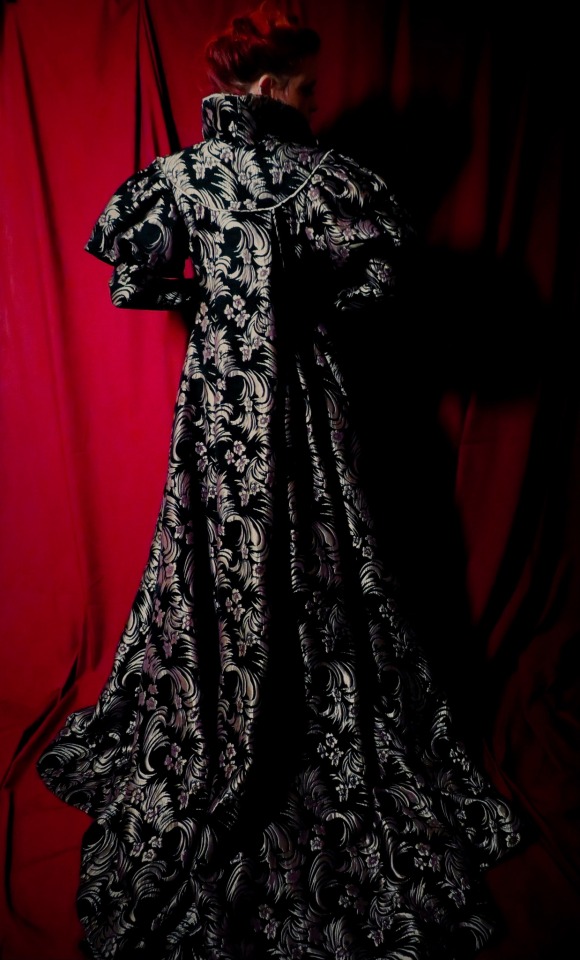

The Madwoman
Aesthetic wrapper, 2020
Upholstery damask, silk ribbon, petersham, steel spun silk
#project: the madwoman#extant projects: 2020#project: aesthetic wrapper#media: crimson peak#(sort of)#victorian#project: historical sewing#historical sewing#historical dress#gothic romance#gothic heroine#Halloween#*claps hands* I love all my terrible photos#crimson peak#ish#heavily inspired#happy Halloween ghouls and goblins!
63 notes
·
View notes
Note
hellooo! 👋
i hope it as okay to tag you in the WIP game!!! 😅😅 you have so many cool projects underway!!
I would love to hear more about your Defiance series! Side stories and spin offs?! What a world you must be creating! 🤩
thanks and have a lovely day !!☀️
Certainly! :D I don't always respond to tag games, but I do always appreciate being tagged in them. This one especially makes for a nice excuse to ramble about projects, and I'm delighted to talk about Defiance~
I'm pretty sure Defiance (the main fic) is the second fanfiction I've ever worked on in earnest and also my first and only longfic (not counting some sort of journal thing for Pokemon X I think I started many years ago, as I quickly lost interest in that project; otherwise, I hadn't really tried my hand at writing fic until 2020, despite reading it for much longer). Back in early 2021, with far too much time on my hands and having recently finished binge-watching all of The Clone Wars TV show, I felt very strongly that Fives needed to live and everyone deserved a happier ending, so I started planning a fix-it (actually the idea may have begun cooking back even before I finished the show, but February 2021 is apparently when I created the first doc).
It, uh, spiraled a little.
The planning/notes document is currently sitting at 102 pages (~46k words) of loose outline, worldbuilding notes, character notes, media notes, etc. The fic document itself is at 127 pages (~49k words) of stuff ranging from rough outline to fully written chapters and outtakes. There is also a Sheets file with timelines so I can track who is where, and when. The Sidestories doc is for ideas that would probably take place during Defiance but not be part of the more central plot, like bonus side chapters, and the Spin-offs doc is for other fic ideas that would take place in the same universe—some of which have graduated to their own documents. Though I've not been making consistent progress in the actual writing and have a very long way to go, I am lost in this sauce.
Anyway, the general plot of Defiance is as follows: unbeknownst to Palpatine and the general public, a timely intervention saves Fives' life. This allows him to actually explain himself to the Jedi, who along with the clones investigate the chips further and work behind the scenes to prevent Order 66 from happening while trying to figure out how to take down who's behind it. Critically, despite their suspicions they do not have hard evidence of Palpatine's involvement, so most events parallel canon up through ROTS with the investigation/preparation taking place discreetly, until the train hops off the rails to avoid sailing off the cliff.
If you'd like a sneak peak snippet, here's the first page or so of the main fic below the cut!
Something is wrong.
The Force is muddled with a constant and indistinct unease, as it has been for years now—moreso on Coruscant than anywhere else, to Shaak Ti's perceptions. Its warnings are difficult to discern with any specificity. Even so, it murmurs them now. And Shaak possesses her own instincts, enhanced by the Force but extant outside her connection to it; these, too, whisper to her that something is wrong, as she watches Knight Skywalker leave the Jedi Temple conference room to find Captain Rex and investigate the situation with Fives.
They are the best fit to track him down and the most likely to confront the rogue clone without further violence. Shaak warned Skywalker that Fives has been acting differently without his chip, that he may not be the man they knew—though she herself is reluctant to believe it—and the Knight and Captain are plenty capable of handling themselves. They will be all right.
Still, something is wrong in a way she cannot yet define, and so Shaak Ti decides to join the hunt.
Since the Jedi have not been asked to search for Fives, she does not contact the Coruscant Guard when she leaves the Temple. Instead she steps out of the building, pulls up the hood of her cloak, and makes for one of the speeder bikes kept at the Temple for general use. It whirs to life under her hands, and she rides to the nearest transportation portal leading down into the undercity.
As she descends, passing speeders of all makes and sizes, Shaak Ti considers what she knows. She is well aware of her own struggles in becoming emotionally attached to the clones; her role on Kamino requires her to balance her care for them as people with the need to defend the galaxy. But many of them, such as Domino Squad, inevitably leave an impression. She watched Echo and Fives grow from bickering cadets to determined protectors, some of the best of their brothers. Her belief in their character during their final tests had not been misplaced. And yet, over these past few days Fives repeatedly defied the Kaminoan doctors, removed his chip, claimed something about a conspiracy, then attacked the Chancellor and fled. Shaak cannot deny these facts, and she must not allow personal feelings to cloud the truth.
Then there are the Kaminoans. Shaak clashes frequently with their attitudes toward the clones, the way they view them as products rather than sentients. Nala Se’s arguments for terminating Tup and assurance that the chips are not a problem fall in line with her position as a manufacturer. And Shaak is well aware that the Kaminoans have not shared all of their secrets with her, as she is not owed them. But the medical scientist's resistance had been… spirited.
None of this paints a clear picture. As they concluded in the meeting back at the Temple, the Jedi need more information.
The familiar sound of a military engine hums past, and Shaak turns her head to watch a pair of gunships heading down the portal through one of the military lanes. She swerves out of the civilian traffic and dives after them, further and further below the surface of the city.
#Thanks for asking! :D#I'm really excited about this 'verse even though it's quite far from getting published#I want to finish at least the first draft of the whole thing before starting to post but that's gonna take quite some time#It'll probably be somewhere between 35 and 50 chapters#Out of which I have...maybe 10-ish written (and around 20 more vaguely outlined). So. Long way to go.#But by golly we're gonna get there!#Patchy Babbles#Patchy Writes#Tag Games
4 notes
·
View notes
Text
Sion Reliquary Bag

Lady Áshildr inn Hárfagri
November 6, 2021
presented at axeman xvi
Summary
Knitting is an old form of textile production, with extant knitted artifacts dated to the 11th century. Our earliest examples of knitting are intricate, well-made pieces made with a mastery indicating a much earlier date of origin. The earliest knit pieces found in Europe are dated to the 13th century in Spain and Estonia. Five knitted purses were found in Sion, Switzerland dated to the 14th century. Knit in silk thread, in the round, and with a "fair isle" type multicolor patterning, these purses have been reproduced and studied by many artisans of the SCA. In this reproduction, I knitted a bag based on Sion relic-purse I, substituting mercerized cotton crochet thread at a larger gauge and to different dimensions to achieve a specific purpose.
Introduction
I have wanted to participate in Arts & Sciences for some time, but could not bring myself to put in the effort necessary for a project just for me. So in true Legion of Swashbucklers fashion, I determined the ultimate means to drum up the effort for a documentable A&S project would be a gift for the Queen of Ansteorra, Her Royal Majesty Elizabeth I, using my experience with knitting.
Knitting as we know it originated sometime before the 11th century, with our earliest artifacts being knitted short row heel socks from Egypt (Tissus d'Égypte). The earliest known knitted artifacts outside Egypt were knitted cushion covers and gloves belonging to Prince Fernando de la Cerda, some time before 1275CE (Rutt).
Five knitted purses were found in Sion, Switzerland dated to the 14th century, first described by Brigitta Schmedding (Schmedding). These bags are knitted from the top down from silk thread, closed with a three-needle bind off, and used two to three colors at a time to make a pattern. Each bag seems to be closed with a fingerloop braid and have a fingerloop braid strap.
I made this bag once before for HE Sara Asshton of York in the 2020 Sable Swap (pictured in Appendix A) and used lessons learned from that project to improve my approach to this project.
Method / Design
For the construction of this bag, I used Aunt Lydia's Classic 10 Crochet Thread in Dark Royal, Golden Yellow, White, and Black on Hiya Hiya US0 2mm double pointed needles.
I used double pointed needles as they are depicted in early "knitting Madonna" paintings such as Master Bertram of Minden's Visit of the Angel, dated to the 15th c and shown below.

Most "knitting Madonna" paintings seem to depict a 3-and-1 arrangement of double pointed needles, with the stitches spread evenly across three needles with one working needle, but I opted to use a 4-and-1 arrangement to better divide my stitches across much shorter, modern needles.

I used mercerized crochet cotton in place of silk for cost and durability concerns. As this bag is to be a gift for HRM Elizabeth, I want it to be a bag she can use and clean without fear of damaging delicate silk or expensive fibers. From prior experience knitting with both cotton and with silk, my joints and fingers suffered far worse with the silk than with the cotton. Because the readily available cotton (Classic 10) is a greater weight than the original silk, I used larger needles and produced a larger gauge than the original item. My gauge worked out to be 5 stitches/cm and 5 rows/cm as opposed to the 7 rows/cm and 5-6 stitches/cm according to Schmedding (using Knytir's translation). T
I cast on the project on August 9 with 14 repeats of the 12 stitch pattern, preferring the Sion I Chart interpretation in DesMoines's pattern to the chart in Lady Tola Knityr's interpretation. Progress pictures found in appendix B. The bag is only made long enough to hold a large phone, and as such does not have the number of rows or requisite tassels that the reliquary bag has.
There is a noticeable difference in gauge from the bottom to the top of the bag. The original is consistent throughout and bound off with a 3 needle bind off. Midway through production I found my gauge with 3-strand colorwork improving, which unfortunately changed the overall gauge. I chose to reverse the construction of the bag such that the firmest, most accurate gauge is at the top of the bag which will receive the most stress from the ties. The loose gauge at the beginning of the project is the result of knowing how an uneven but too-tight gauge makes colorwork "pucker" in an unsightly fashion, and that floats too loose but unseen on the back side of the product are typically more tolerable than too-tight floats with puckering.
Ends are left untrimmed inside the bag to allow repair options, as the cotton is slippery and I do not trust its ability to stick to itself should I simply weave in the ends and trim. If this bag begins to unravel, I wish to fix it.
The fingerloop braid closure is left off pending the presentation of the gift to the recipient, as it affects the fabric and if she has no interest in the drawstring closure there seems no point in needlessly altering the fabric itself.
Conclusion
If I ever try to knit 3 strand color work again, throw this paper at me.
Bibliography
DesMoines, Anne. Reliquary Style Pouches.
(downlaoded May 2020)
Knytir, Tola. Sion Knitted Purse.
(accessed November 1, 2021). Found in part here
20-knit-purses-in-14thc-switzerland/
Rutt, Richard. A History of Handknitting. Interweave, 1987.
Schmedding, Brigitta. Mittelalterliche Textilien in Kirchen Und KloÌstern Der
Schweiz: Katalog. Bern: StaÌmpfli, 1978
Tissus d'Égypte: témoins du monde arabe, VIIIe. - XVe. siècles. Collection
Bouvier, Exposition 1993-1994, Musée d'art et d'histoire à Genève. 1994,
Institut du monde arabe à Paris.
APPENDIX A
APPENDIX B

August 10, 2021


October 15, 2021


October 20, 2021


October 28, 2021

Blocking the Final Product October 28, 2021
Thank you for reading this kthxbai
#sca#society for creative anachronism#arts & sciences#knitting#historical knitting#sion reliquary bag#colorwork knitting#fair isle#knitting in the round#a&s#submitted A&S entry#A&S paper
3 notes
·
View notes
Text
Sessão Mutual Films: Nossa própria imagem, um espelho de beleza: Os filmes de Camille Billops e James Hatch [Mutual Films Session: Our Own Image, A Mirror of Beauty: The Films of Camille Billops and James Hatch]
March 11: The link above leads to Portuguese-language information about the 22nd edition of the Mutual Films Session, co-curated and organized by me and Mariana Shellard, whose screenings will take place between March 12th and 31st at the São Paulo-based unit of the Instituto Moreira Salles and on March 23rd and 30th at the newly opened screening room of the Instituto's unit in Poços de Caldas.
The event provides Brazil-based audiences with the country's first-ever retrospective of the films of Camille Billops (1933-2019) and James Hatch (1928-2020), a team of American artists and archivists that made brilliantly self-reflexive documentaries, several of which are focused on members of Billops's family, who come to represent different aspects of African-American life. The films investigate with profundity, wit, and humor an American condition of cracked interiors covered up by smooth surfaces, with the eternal hope of creating a less hypocritical and more open world.
The series's three programs will present newly digitized copies of all six of the films made by Billops and Hatch (who, among other things, founded the Hatch-Billops Collection, currently stored at Emory University and one of the largest extant archives devoted to African-American art and culture). Five of the films have been remastered in 2K, an initiative undertaken by their longtime distributor, the New York-based Third World Newsreel. The sixth - the couple's remarkable early portrait film of one of Billops's cousins called Suzanne, Suzanne - has been restored in 4K by the nonprofit entity IndieCollect.
The filmic works of Billops and Hatch received much positive feedback during the directors' lifetimes, but their reception has experienced a renaissance during the past few years thanks in good part to the availability of these new copies. Among critical texts that have recently been published, a piece by Yasmina Price written in conjunction with a streaming series of the couple's films on The Criterion Channel is particularly full. Contemporary researchers are fortunate to be able to have access to multiple interviews that Billops gave, including a long conversation from 1996 with bell hooks (included in hooks's book Reel to Real: Race, Sex, and Class at the Movies, whose Brazilian edition was published late last year by Editora Elefante) and a 1992 talk with Ameena Meer for BOMB Magazine that we were fortunate to be able to translate into Portuguese for our website.
The series's opening screening in São Paulo on March 12th will include a public post-screening conversation about Billops and Hatch's films with Aline Motta, an important contemporary Brazilian artist whose multidisciplinary works contain points of resonance with the couples' projects. The series is dedicated to the memory of the German filmmaker and activist Renate Sami, and it could also easily be dedicated to the memory of Philip Shellard, a quiet and generous recently deceased cinephile whose accomplishments include being Mariana's father and a figure of unrelenting support.
0 notes
Text
2020 Wrap-Up
December 30, 2020
This hell year is finally ending, so I wanted to look back at my successes from this year.
Goals
Back in January, I set some sewing goals for myself. My goals were not project-based this year, though that will be changing next year, as you'll see soon.
Goal 1: Stash busting. I did really well with this goal! While my stash isn't significantly smaller, it also wasn't overly large to begin with. Only two projects (my white Regency dress and its petticoat) used exclusively new materials, but that dress has been in the planning stage for upwards of six years so I don't feel the slightest bit bad about it.
Goal 2: Better habits in general, including pressing my seams and not sewing over pins.
I am pleased to announce that I have been pressing all of my seams this year. Unfortunately this led to me finally killing my mom's 25-year-old iron, but I bought a new one which was exciting in its own way.
I think I was good about not sewing over pins too, but it's been a few months since I did any machine sewing and I can't remember. I definitely think about it more, though, so there's that.
Goal 3: Learn embroidery.
I have some embroidery experience, but I jumped at the chance to learn more when a friend pointed me toward "Take a Stitch Tuesday" from PinTangle. Each Tuesday is a chance to learn a new embroidery stitch/technique. I got behind sometimes, but I always caught up!
What did I learn?
Now, better habits isn't the only thing I gained this year. I learned a lot of new skills too!
My first new skill this year was buttonholes. And in the "go big or go home" mindset, my first project of the year involved twelve of them, and I did five more across two different projects later in the year.
Skill number 2 was a zipper. I have never sewn a zipper before in my life, but I managed to set an invisible zipper correctly on the first try! It's amazing what you can do when you read the instructions instead of winging it.
Skills 3 & 4 are using a gridded pattern and (drastically) altering a pattern. I used a gridded pattern as the base for my Regency dress. It was taken from an extant garment, so it was only one size and required some adjustments to fit me. There's also the fact that I was going for a different sort of closure and had to make some additional alterations.
Project Round-Up
The "Girl Detective" Dress, McCall's M7470 (machine construction, hand finishing, needs minor alterations)
A small pillow from the remnants of my curtains (machine sewing)
Green Regency dress alterations (hand and machine sewing)
49 masks - seven to donate, the rest for me and my family (machine sewing)
Vintage Simplicity skirt (machine construction, hand finishing)
Sewed 22 decorative patches onto my denim jacket
1920s brassiere
Regency petticoat (machine sewing)
Additional boning for Regency short stays (handsewn)
Adding buttonholes and a drawstring to my sibling's pajama pants (handsewn)
Faux coral jewelry set - A matching necklace, bracelet, and earrings made using faux red coral beads
White Regency dress (handsewn)
18th century neckerchief/Regecy fichu (handsewn)
Pieced 18th century pockets (started, but unfinished)
Doll-sized shift and petticoat
Followed along with "Take a Stitch Tuesday" (a weekly embroidery challenge) from Pintangle
My creativity and motivation really came in waves this year. The mini pillow, 50s skirt, 20s bra, and some masks were all done in the month of May. Then nothing in June. Then my Regency petticoat and green dress alterations in July and the entire white Regency dress and more masks in August and the first week of September. Later in September I started a pair of heavily pieced 18th century pockets, but it's now December and they're still not done.
I have hope for next year, though. I intend to start strong with some simple machine sewn projects for the sake of stash busting and immediate gratification (namely curtains and pillowcases), then get back to historical sewing (but you'll hear more about that soon ;) ).
I also have a new sewing machine to get acquainted with! I've been using my mother's machine up till now, but back in August I received a second-hand machine from a friend's grandmother (who is in good health, she just wanted a new machine for herself, and my friend already has a machine of his own). It's a different brand than my mother's is and has a lot more knobs and levers, so it's a little intimidating!
I hope you find something positive to hold on to from this year, and I hope you have something to look forward to in the coming year. Take care of yourself and take care of each other.
Stay warm. Stay safe. Stay healthy.
0 notes
Text
the cycle of me realizing over and over i dont know how to make Ellie a good villain
#toy txt post#ocs#like as in i dont know what her motivation is beyond some like personal issues with Birdie#i dont knkw what she says her motivation is. but she is supposed to be birdies big antagonist but its a STRUGGLE bc everything is hollow and#empty rn bc i dont have a good motivation for her! and briefly i thought i had something in like. her being anti-science anti-hybrid magic#but i dont know how to make that WORK exactly w the magic systems i have so far#and i also dont know to what extant that would be like how far do i take that?#does she believe in medicine? is she an anti-vaxxer? does she still believe in miasma theory? fucking humoral?? that doesnt work for me#esp bc i kinda want the witch community to he Ahead of humans at least a little in figuring out like. germ theory etc. we took way too long#with that yknow? i want Birdie already doing Genetic Modification Mad Science Magic in her basement in the victorian era at the latest#i was joking awhile ago in the group chat the Ellie would technically be anti vax for her personally. but if you put her near anti vaxxers#she'll destroy them in seconds. and 2020 shouldve made this EASIER bc like we've all seen now. the bullshit that ppl will believe despite it#making no sense despite it being contradictory to their other beliefs despite it being hypocritical like it should be easier than ever to#make a villain who believes hypocritical contradictory dumb shit and yet. i cant. im struggling#what does Ellie want? she wants to politically take over the witch council. for one#why does she want that? to change things. (BUT WHAT THINGS??) frustration with how slow it is? and to specifically usurp Birdie.#turn them all against Birdie. have birdie exiled and put to death (well. she'll try. shes just making a deadly escape room)#why does she want to turn them against Birdie? she feels wronged by Birdie and is definitely projecting a whole lot of shit onto Birdie#for Birdie refusing to continue to teach her after finding out her views on Something. she Scared Birdie. Birdie had already been reluctant#to take on any pupils and she took a chance on Ellie after Ellie kept begging her to mentor her. and she regrets it#and at some point Ellie starts revealing ideologies that disturb Birdie. originally this was going tk be her extremist puritanical views on#magic. a vehement hatred for hybrid magic which she doesnt know/understand yet that birdie practices hybrid magic a lot#and Birdie gives up on her. she cannot keep teaching her. she hates the hybrid magic. and so she essentially abandons Ellie#and then Ellie latches onto that and projects a whole lot of shit onto Birdie. she hates birdie so much and wants to defeat her and destroy#her. but theres still a part of Ellie that wants Birdie's approval. which only makes her angrier and more unhinged when she tries to make a#creature like birdies creatures. and birdie is horrified by it. bc siiyr was not made well. she is created of suffering and pain and its bad#and i just. theres so much missing from ellie. there's so much there with her passion and feelings and shit. but#in terms of motivation. she feels Empty. not even like a proper fake motivation. bc i want her to have that too. it was originally her real#thing. that Birdie rejected her for. and then after birdie rejected her she Uses whatever that ideology is to get ppl to follow her.#and then at the end the world is in shambles bc of Ellie. whatever she does. its catastrophic. and she didnt predict it. she wasnt prepared
4 notes
·
View notes
Text
Beat Sheets, or, how Natalie published 3 novels in 1 year
(Thank to @butchwacked for making me put this into words the other day)
So! With my first book having come out at the end of 2020 and my third coming out next month (go pre-order In the Court of the Nameless Queen, it's got spiders in it) along with all the short stuff and Patreon posts in between big projects, some people have asked me "Natalie how the hell do you write that much?" Well, here's my process.
I've said before that I'm a meticulous plotter and I try to plan and outline everything, and what that looks like in execution is that the secret to my success is the magic of the bulleted list.
Phase 1: Idea Dumping
I write down every idea that comes to me, no matter how dumb or nonsensical or convoluted it sounds at the time. Like this:
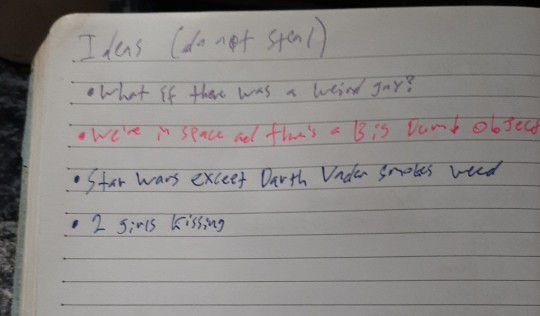
I do all of this longhand in glitter gel pens, but it can be adapted to whatever your process is.
This gives me a pool of concepts I can draw upon to ponder & expand whenever it's time to start something new or add to something extant. Now I pick an idea from the junk drawer and think about how I might turn it into something.
Part 2: The Rough Outline
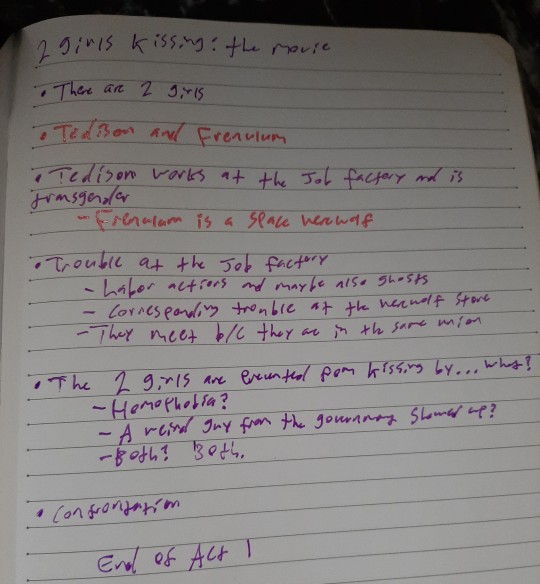
Next I start jotting down characters, setting ideas, story beats, etc as they occur to me. After a while, things start to fall into some semblance of order and I start to see things like major story beats and overarching themes. I develop an idea of what the story is and where it's going, and soon I've got the rudiments of a beginning-to-ending road map as convenient bullet points.
Part 3: Populating the World
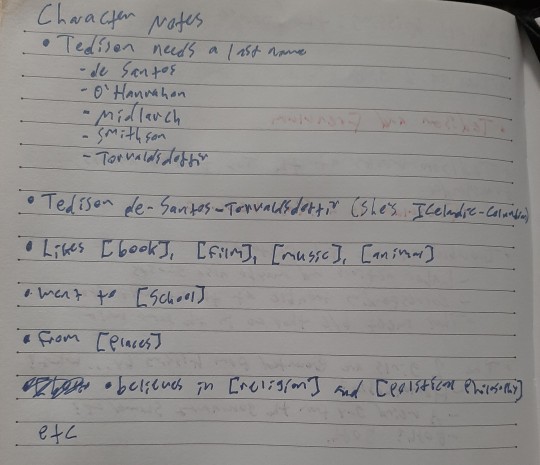

Things that need expanding upon get their own lists. Stuff like worldbuilding, locations, and character development are obvious, but this also applies to original or otherwise alien concepts (like whatever the hell a "space werewolf" is). Now the world is coming alive and its rules & logic start to make sense.
Part 4: The Beat Sheet

Next I return to the rough outline and zoom in on it, visualizing scenes and writing them out beat-by-beat. This can take a long time, but it's not all that daunting when you remember that you only need one brief bullet point per beat. Pretty soon, I've got a series of bullet points that'll take me from the beginning to the end.
And here's the real Michael's secret stuff: You remember padding essays for length in English class? In theory, each one of those bullet points only needs to be expanded into 1-4 paragraphs of prose to tell a fairly decent story. I do that, I've finished a rough draft; and it's always easier to expand upon, fix, beautify, or otherwise deal with a rough draft once you've got the thang ding written.
399 notes
·
View notes
Text


Walking through the neotropical forests of Mexico’s Yucatan peninsula today, encountering a feral colony of Melipona beecheii -- a particular kind of native, stingless bee -- would be highly rare. Most extant colonies are kept by a dwindling number of local practitioners, and those that still live in the forest are highly elusive, pollinating only the highest levels of forest canopy. Yet these bees, called xunáan kab (“lady bee”) in Mayan, are living metronomes, embodying forest histories and marking out ecological time in distinctive ways.
The history of xunáan kab is tied to the regional landscape, both socially and ecologically. Pre-Colombian Maya communities held the xunáan kab bee in esteem for millennia, integrating the small insects into [...] mythology [...], and relying on their honey as a nutritious food staple. [...].
---
The story of ecological destruction and colonization in Yucatan has been narrated through the lives of nonhuman species before. Yet the species that get to tell these stories are often the ones that make the biggest impact, with easily distinguishable introduction events or punctuated bursts of ecological disturbance. One of these is henequen, a kind of agave that became highly valuable for its use as a fiber.
In the late 1800s, much of the old-growth forest of the central peninsula was cleared to make way for vast monocultures of the plant.
The boom (and subsequent bust) of “King Henequen” continues to dominate the version of regional history that most tourists to the region encounter, with plantation tours and Merida’s neoclassical architecture the most conspicuous memorials to Yucatan’s “golden age.”
---
In contrast, the story of xunáan kab is one of quiet resistance -- a steady hum from the margins of the forest.
It may have been on account of xunáan kab, for instance, that the European honeybee (Apis mellifera) was not introduced to the Yucatan peninsula until the mid-twentieth century, centuries after its introduction by the Spanish to other regions in Mexico. The abundance of xunáan kab hives, allowing for the steady supply of honey and wax as forced tribute to the colonizers, negated the need for their replacement or supersedence with other introduced species.
In this respect, xunáan kab is a ghost of ecologies yet to be, a vanguard against unrealized ecological destruction. [...]
The beekeepers of Zutut’ha are only one thread of a larger regional struggle in which indigenous communities and meliponicultores (keepers of the xunáan kab) have long been involved, especially with regard to the region’s biocultural heritage. Though the practice of meliponicultura has gradually declined, it has by no means disappeared -- [...] many persist in cultivating native bees, sharing hive divisions among close contacts. Recently, there has been renewed interest in the medicinal properties of xunáan kab honey [...]. The decline of the health of the forests leaves the future of xunáan kab uncertain. This decline is shaped by more irregular blooming periods caused by climate change, the widespread use of pesticides, and deforestation caused by the encroachment of industrial agriculture plots and touristic development projects.
---
Headline, image, caption, and text published by: Olea Morris. “Xunáan Kab Rhythms: Native Bees and Ecological Change in Yucatan, Mexico.” Environment and Society Portal, Arcadia no. 6. Summer 2020. [Bold emphasis and some paragraph breaks added by me.]
1K notes
·
View notes
Text
Women’s Outdoor Apparel: In Historical Context
If I had the opportunity to conduct a research project with unlimited funds, I would do it on the history of women’s outdoor gear. Historical Fashion has always fascinated me, and in recent years my attention has been drawn to the severe gaps that remain in outdoor gear and apparel aimed toward women. For instance, there is an ongoing joke between my friends and I (that has proved true many a time) that all financially accessible women’s outdoor apparel companies only make outdoor wear in the colours black, fuchsia, or teal. Historically, women’s active and outdoors wear has always been a few steps behind that of men.
For example, in 1943 most male sports players were fighting overseas in World War 2, and Philip Wrigley formed the All-American Girls Professional Baseball team, on which the players wore a one-piece skirted uniform as opposed to pants. Women were meant to “look like ladies, but play like gentlemen” (Porter, 2020). From my 11 years playing Softball, I can tell you that sliding into home with anything less than full length pants and sliding pads will leave you with some very unladylike scars.

Dorothy “Dottie” Kamenshek, First Basemen for the Rockford Peaches jumping to catch a ball in her uniform, from the National Baseball Hall of Fame, from: https://www.enidnews.com/news/league-of-their-own-women-baseball-players-together-again/article_aa96deac-d474-5e3e-8fa6-9443f239aa89.html
In another example, the 19th century and industrial revolution led to much more expendable income in families and led to more women joining their husbands in outdoor pursuits like yachting and mountain climbing. MacIntosh rubberized-cotton raincoats were patented in 1823 and became quite popular in 1830 following their roll-out to military men, but the popularization of waterproof outerwear for women and subsequent design of fashionable styles would not come until the 1880s and 1890s (Shepard, 2012).
If I had unlimited resources, I would do a deep dive into the history of women’s outdoor wear from woolen shawls and tunics to Helly Hansen Jackets, complete with trips to fashion museums to view extant garments, conversations with historians and modern garment makers, and a look into why so many gaps between men’s and women’s outdoor wear exists.
Ethically, this project would ideally not be a large undertaking. It would focus mainly on compiling existent research and speaking with experts only on the basis of their past research and findings, so factors like engagement with vulnerable persons, power imbalances, and most risk factors would likely be easier to avoid. However, there is always economic and social risks to these experts should they speak ill of their institutions or design companies, so this would need to be addressed. Of course, free and informed consent is also a factor in these interviews, as is respecting participant privacy.
This research would be proposed as a way to help outdoor gear and apparel companies better connect to the wants and needs of outdoorswomen, and as a way to bridge the gap between fashion design and user practicality. It would help gear companies and women by furthering the conversation around past and current inequities between men’s and women’s ability to access the outdoors. It would help expedition leaders and companies in better addressing the gear needs of women who enter their programs.
Reference List:
Porter, M. (2011, March 27). When women ruled baseball: The AAGPBL. HowTheyPlay. Retrieved January 29, 2022, from https://howtheyplay.com/team-sports/When-Girls-Ruled-Baseball
Shephard, A. J. (2012). Waterproof dress : An exploration of development and design from 1880 through 1895. Clothing and Textiles Research Journal, 30(3). https://doi.org/10.32469/10355/6182
3 notes
·
View notes
Text
We don't know why you don't want to have public sex

Evolutionary psychology is beloved of a certain kind of "rationalist" who loves a good just-so story that casts some system that advantages him as biologically inevitable, as in, "Honey, the only reason I'm screwing my undergrads is because of bonobos."
There's a tried-and-true formula for evo-psych storytelling: first, find an animal that acts in a certain way. Next, make up a story explaining that behavior. Finally, project that behavior on proto-hominids whose social lives are totally unknown and unknowable.
Put a bow on it by explaining that these animals show that these protohominids did whatever it is people are angry at you about, and then declare that your DNA requires you to do that.
Evo-psych doesn't have to be sexist, but it usually is, and so it usually falls to women to debunk these idiotic claims.
A good example is Jordan Peterson, whose theories of gender essentialism are built on the mating habits of a certain lobster species.
Periodically, women, especially marine biologists, have done the important, thankless work of explaining that Peterson is cherry-picking here. Take Bailey Steinworth's incredible 2018 thread on marine invertebrate reproduction:
https://twitter.com/baileys/status/997646354414522368
Steinworth wants to know why lobster sex is the exemplar we should use to explain human sexuality, rather than, say, sea hares, hermaphrodites that"lay their eggs orgy-style with each individual simultaneously acting as male and female in multiple couplings."
Sea hares know how to have a good time!
"If only two are available, they take turns being 'male' and 'female.'"
The genre of "women scientists explaining why evo-psych is pseudoscientific horseshit" is large and excellent, but one practitioner stands out above all others.
Anne Innis Dagg recently won the Order of Canada for her outstanding work as an evolutionary biologist. Dagg faced vicious discrimination throughout her distinguished scientific career.
She was never tenured, even after decades at the University of Waterloo, where she was my undergrad advisor.
In 2004, Dagg published "Love of Shopping Is Not a Gene," the ur-text of the field.
https://boingboing.net/2009/11/04/love-of-shopping-is.html
It's a short, sprightly book, as much an ethnography of evo-psych supporters as it is a scientific debunking of the field.
(If you're interested in learning more about Dagg, she's the subject of a brilliant new doc, "The Woman Who Loved Giraffes")
https://pluralistic.net/2020/02/19/pluralist-19-feb-2020/#annedagg
The women who do this important work really epitomize the "everything the men do, but backwards and in heels" nature of so much anti-misogynist work. They have to out-rationalism the "rationalists" who promote evo-psych.
And they have to do so while being as entertaining as the just-so pseudoscientific tales they're debunking, without being able to cheat by presenting their own fancy as science.
Which brings me to this week's backwards-in-heels champion, Rebecca Watson, AKA Skepchick, a frequent target of harassment by terrible men and a fearless science communicator who is as entertaining as she is correct.
https://www.youtube.com/watch?v=eG5iiYJvjsw
Watson's latest is "Why Do Humans Have Sex in Private? Evolutionary Psychology has a Guess" - a teardown of Yitzchak Ben-Mocha's evidence-free paper arguing that we screw in private because men don't want rivals to get horny and screw their mates.
https://royalsocietypublishing.org/doi/10.1098/rspb.2020.1330
The paper may be evidence free, but it's not devoid of argument. In the grand tradition of evo-psych, Ben-Mocha combines an observation about contemporary norms (the propensity of survey respondents to have sex in private), which he then projects back to prehistory.
As Watson notes, "behaviorally and cognitively modern humans have been around for about 50,000 years, and unfortunately we don’t have many extant sex tapes from the earliest part of that period."
Ben-Mocha proposes this is genetic, locating a bird species, the Arabian babbler, which seeks out private matings. Ben-Mocha proposes (but has no means of validating) explanations for this, decides that one is more likely than others, and therefore it's probably true.
Having decided Arabian babblers are "cooperative breeders" he concludes that humans are probably also genetically disposed to screw privately because of the same imaginary reason that one species of avians, who genetically diverged from mammals millions of years ago are.
Watson really does good work laying out both the thinness of this paper and the absurdity of its warm response.
If videos aren't your thing, here's a transcript:
https://skepchick.org/2020/08/why-do-humans-have-sex-in-private-evolutionary-psychology-has-a-guess/
Here's her closer: "there is zero evidence that you inherited a preference for fucking in private from your parents, that you fuck in private because men want other men to still be their bros, or that’s even what is happening in bird populations the study is based on."
"You may as well say that humans evolved a gene that allows us to hold in a fart around someone we find attractive. Not everything is an adaptive trait."
If you like Watson's work and want to see more of it, here's her Patreon:
https://www.patreon.com/rebecca
91 notes
·
View notes
Text

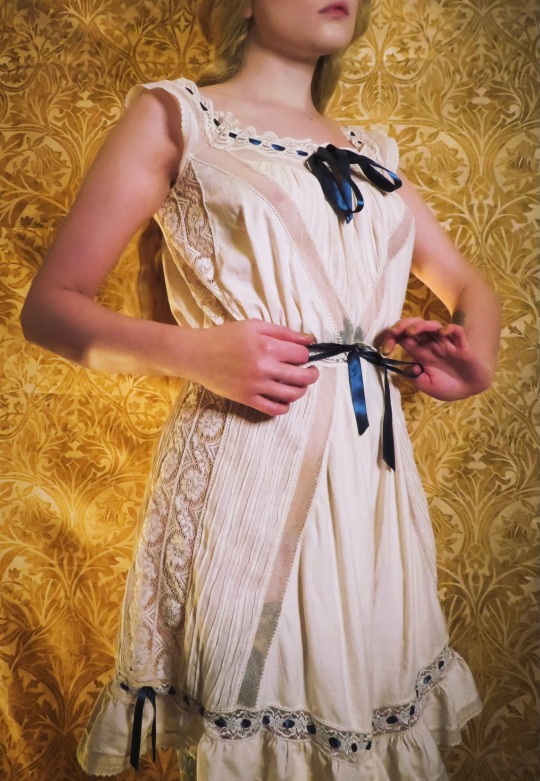

Princess Zelda, 2020
False combinations with s-bend corset
Organic cotton/linen, cotton dobby, cotton lace, silk thread, satin ribbon
Silk matka, cotton coutil, cotton poplin, satin ribbon, cotton lace, antique brass suspenders
#project: Princess Zelda#media: Breath of the Wild#media: the legend of Zelda#the legend of Zelda#triforce#princess Zelda#breath of the wild#Edwardian#underpinnings#combinations#corset#historical sewing#historical dress#cosplay#needlework#hand sewing#costume#extant projects: 2020#another of my favourites
57 notes
·
View notes
Text
My therapist asked me why it is that my rage against xtianity is coming up now and I'm just... I don't know how to tell him that, for me, it's never not coming up.
It was my life, my truth, I related literally everything to it and everything I did kept it in mind. I was raised in it, and molded in it, and it was very much a part of who I was.
I spent 2 whole days a week every week in church during the school year - and at least 2 hours most days during summer. I prayed over every snack and discussed religion with my parents - everything was supposed to be as g*d wanted it, so I had to check. I worked in the church. I babysat the church babies. I helped edit sermons. I sang and played in the activities. I sought out xtian literature to read, xtian friendly media to watch, and heavily avoided anything from atheist or non-xtian sources. "Secular" was a bad word in my house on par with calling something "evil." I missed a lot of what people would consider 'normal' childhood.
My school projects were encouraged to be xtian-influenced and my parents gave the impression that they were being very magnanimous about allowing me to love fantasy books because magic was evil and fake. My grades had to be high, my attitude perfect, my looks modest and humble but clean and 'healthy' (thin & blemishless) - because I was always being watched by and always representing g*d.
I was encouraged to go to school and be loud about opposing cultural learning, evolution, abortion, racial sensitivity, and so on - even "against the grain" because I was a "soldier for the truth" and "saving" people. I believed that I had to be ready at any moment to kill or be killed in the name of g*d. I believed that I would have to watch any friends I didn't convert be tortured forever in hell from heaven. I stayed in the closet because that was my sin and "cross to bear".
When I went to college, I took classes to try and strengthen my xtianity. I thought science and ethics and history aligned perfectly with the b*ble, so I took ethics and philosophy and science and history - and it didn't. But my immediate response wasn't to say "maybe my religion is just a religion and not a scientific and historical thing" - I tried to say everything against the things I had originally been taught was wrong until I realized I couldn't keep lying. And if... If a lot of it was wrong, could any of it be true? I dug and dug and sought out any way I could verify and protect my faith, but xtianity is just not defensible at its base. Not historically, not scientifically, not even morally. I desperately clung to it into 2020, even with nothing left to cling to. Because who am I without g*d?
You don't just leave that, you have to tear out everything you know - everything you have ever thought. This was my entire NURTURE part of the whole nature / nurture bit. Every single action, every single emotional response, every bit of subconscious being is trained and tainted by this huge, ever-present abusive relationship with a demanding, non extant entity.
And I can't escape it! Xtianity is everywhere! And when I say, "yeah I'm an apostate," I have to block about 3,000 random people and 3 friends from evangelizing to me. Even the nice, atheist ones are like, "oh but not all of it's bad, you don't need to be so angry and aggressive about it."
I'm trying to tear the mycelium base out of the forest of my mind and replace it, without killing the entire forest. And I keep finding little chunks that I missed.
So I'm frustrated. All the time.
15 notes
·
View notes
Text
2020 Recap
no
2021 Goals
Revert at least to pre-2020 depression levels. System restore or smth
Don't get COVID! Do get a vaccine.
Negotiate split shifts at work Already failed that one! That’s on me for opening my mouth in 2020
Successfully adopt a dog
Capture some toad bugs! Did not find any 2020, would like to try and keep a captive population
Be brave on Discord for 20 minutes and trade for fruit in Animal Crossing
ACQUIRE RENEIGH. And the scarecrow DIY, Roscoe, please
Finish my extant comic project and get started on the others
More drawing! Especially more sketches; gotta break from the perfectionist death spiral. Also surprised at how, no matter how awful I felt, especially after Zena died, I still had an urge to create, so that’s one area where I can definitely say I’ve had worse years.
I have 21000+ words invested in a Touhou fanfic, I should work on that some more...similar situations in the Batfic folder...and my self-indulgent TES story! My goodness do I have a lot of words rotting away on my hard drive.
Get a doctor to give me a physical! (The ER didn’t count!) Do something other than give me a flu shot ffs
Don’t die
Don’t kill anyone else. Sending death vibes does not count
All the trees near me will stay vertical please and thank you
I will be grading myself on this and posting it will make me feel accountable; however, I tried to set the bar pretty fuckin low
17 notes
·
View notes
Photo


Introduction
My Final Research project for Practical Assessment 1 is going to be the examination, reconstruction and discussion of a William Travilla designed costume for Marilyn Monroe from the 1956 film Bus Stop. My desire to research the costume comes from an appreciation of the storytelling, construction, and experience of the actor wearing the costume. What does the costume tell us? What did the designer include and why? How was it made? What did designing it this way achieve and communicate? How would the actress have felt wearing the costume? Would it have impacted her performance? All these questions and more are what I would like to answer during this project. The specific costume I have chosen is Monroe’s boned, satin green showgirl leotard which her character, Chérie, wears throughout her saloon scenes of the film (Bus Stop, 1956). I have chosen to replicate this costume because it is a perfect example of the overlooked complexity of historical film costume and visual storytelling through costume. The costume has a complicated inner construction specific to the period and the design and condition of the costume was deliberately chosen by Monroe and Travilla to communicate to the audience Chérie’s lower status as a novice chanteuse immediately (Hansford and Homer, 2011, pp. 152-153).
To best visualise and communicate this process I have chosen to follow the work of YouTuber and Dress Historian Bernadette Banner, who studies historical dress through practical experimentation and documents her projects via long-form videos (Banner, 2021). The reason I have chosen to examine her methodologies and way of working is because I believe her videos are an effective and engaging way of communicating and displaying her research, process, and reflections throughout, similar to what I intend to do. The value of her method is praised in this 2020 article from Hyper Allergic, where they say, “Her discussions are rooted in a combination of extant garment… and secondary sources stitched together with educated guesses… to me they (Banner’s videos) read like gorgeously crafted lectures backed by thoughtful research, evidence selection, and time.” (Hyde, 2020). Banner’s style is, as the article said, very similar to a lecture in the sense it is researched and methodical but also conversational and open, following leads and thought processes which occur during the recreation of pieces. This style allows for an encompassing look at the costume, its construction, the context of the garment and any other issues which arise during her process. Inspiration from this structure I think would benefit my project because it is methodical but also open to exploring avenues and discussions which are unearthed during the process.
7 notes
·
View notes
Photo
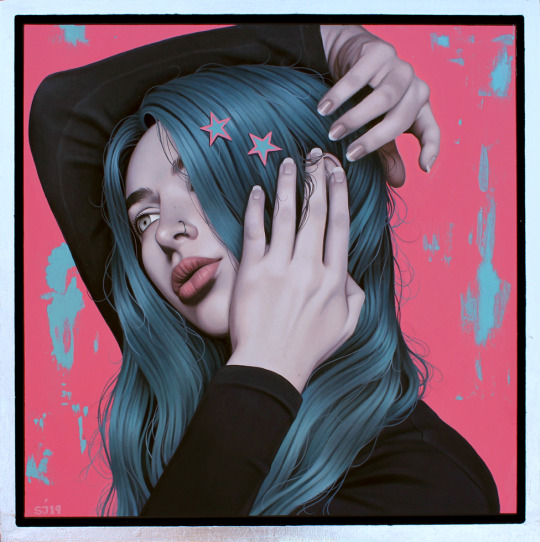

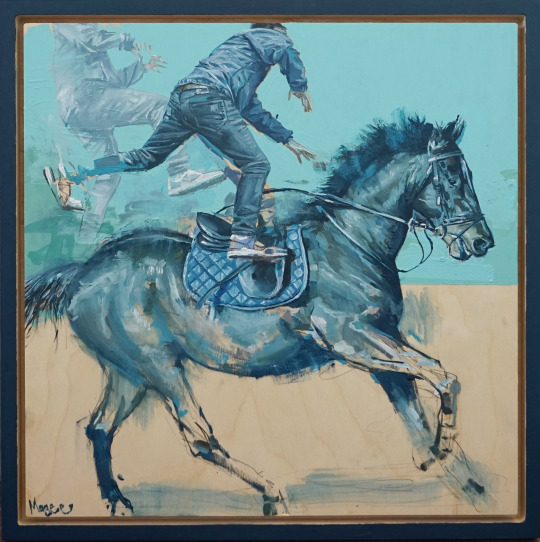

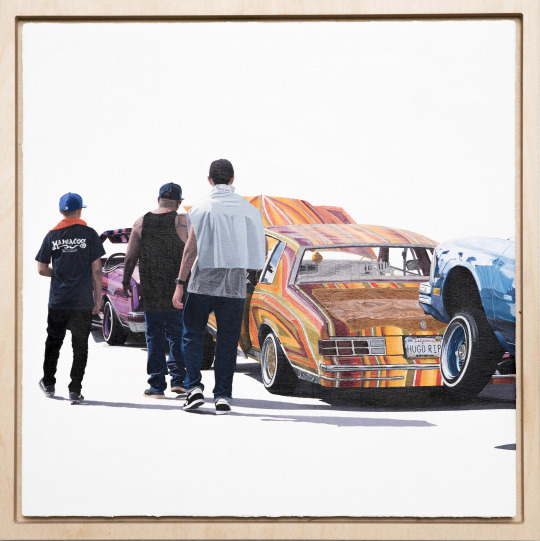

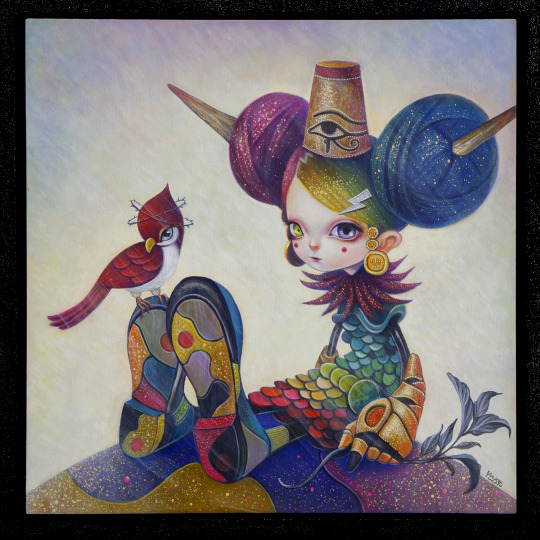
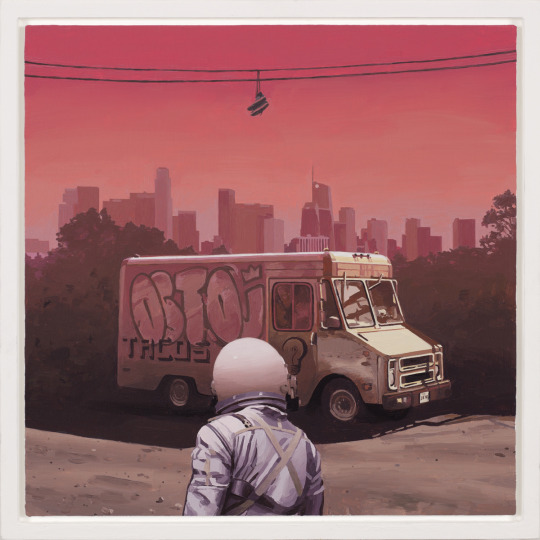
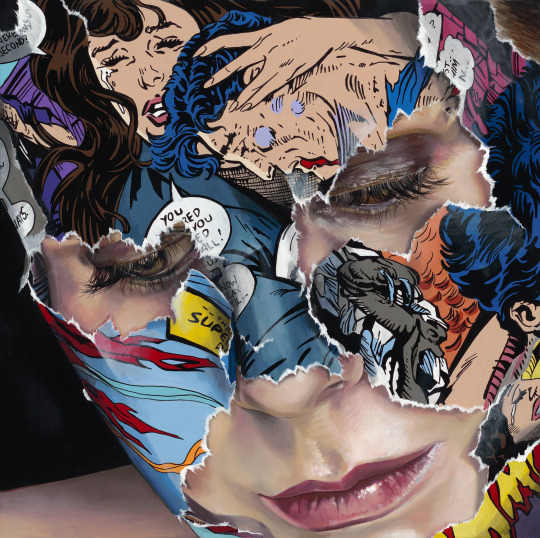
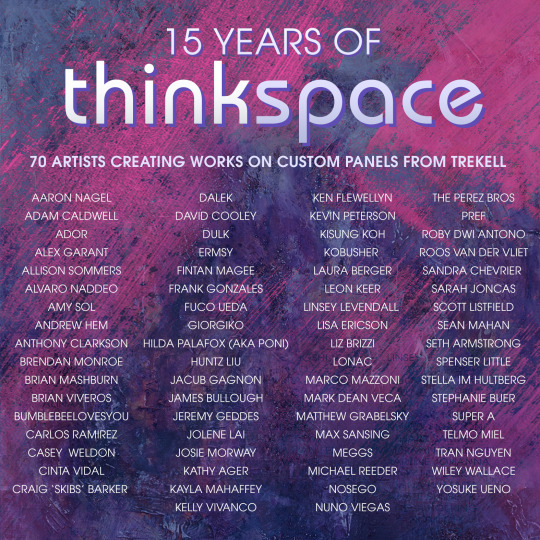
15 Years of Thinkspace.
Opening on Saturday, January 11th, 2020 at Thinkspace Projects in Los Angeles, California is their massive group exhibition celebrating their 15 years of being open.
Thinkspace was founded back in 2005; now in LA’s Culver City Arts District, the gallery has garnered an international reputation as one of the most active and productive exponents of the New Contemporary Art Movement. Maintaining its founding commitment to the promotion and support of its artists, Thinkspace has steadily expanded its roster and diversified its projects, creating collaborative and institutional opportunities all over the world. Founded in the spirit of forging recognition for young, emerging, and lesser-known talents, the gallery is now home to artists from all over the world, ranging from the emerging, mid-career, and established.
“15 Years of Thinkspace” will feature works from 70 of their artist family members from around the globe. All the works will be created on custom 15 inch wood panels with a built in floater frame made and provided by Trekell Art Supplies out of Southern California.
Not unlike its earlier 20th Century counterparts like Surrealism, Dada, or Fauvism, The New Contemporary Art Movement ultimately materialized in search of new forms, content, and expressions that cited rather than disavowed the individual and the social. The earliest incarnations of the Movement, refusing the paradigmatic disinterest of “Art” as an inaccessible garrison of ‘high culture’, championed figuration, surrealism, representation, pop culture and the subcultural. By incorporating the ‘lowbrow,’ accessible and even profane, an exciting and irreverent art movement grew in defiance of the mandated renunciations of “high” art. Emerging on the West Coast in the 90’s partly as a response to the rabid ‘conceptual-turn’ then championed on the East Coasts, the Movement steadily created its own platforms, publications, and spaces for the dissemination of its imagery and ideas.
Though the New Contemporary Art Movement has remained largely unacknowledged by the vetted institutions of the fine art world and its arbiters of ‘high culture,’ the future promises a shift. The Movement’s formative aversion to the establishment is also waning in the wake of its increased visibility, institutional presence, and widespread popularity.
Thinkspace has sought to champion and promote the unique breadth of the Movement, creating new opportunities for the presentation of its artists and work. Though still very much invested in the elevation and exposure of its emerging talents, the gallery, now in its 13th year, has come into its own with a roster that reflects this maturity. An active advocate for what is now one of the longest extant organized art movement’s in history, Thinkspace is an established voice for its continued growth and evolution.
The gallery has in recent years expanded its projects beyond Los Angeles, exhibiting with partner galleries and organizations in Berlin, Hong Kong, London, New York City, Detroit, Chicago, and Honolulu among many others, participating in International Art Fairs, and curating New Contemporary content for Museums. Committed to the vision, risk, and exceptional gifts of its artists, the gallery is first and foremost a family. From the streets to the museums, and from the “margins” to the white cube, Thinkspace is re-envisioning what it means to be “institutional.”
The exhibition will be on view until January 25th, 2020 and should not be missed under any circumstances if you’re in the Los Angeles area.
-
Be sure to follow Supersonic Art on Instagram!
188 notes
·
View notes
Text
Sewing a Regency Gown Part 5 - Photos and Inspiration
October 8, 2020
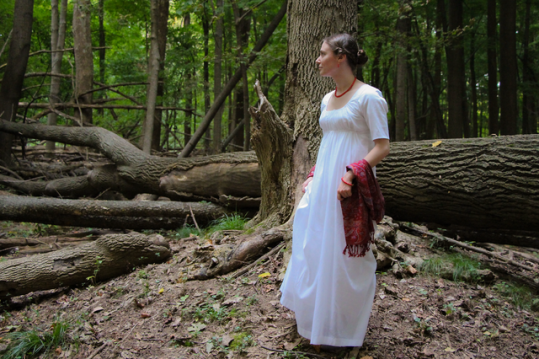
[Image ID: a photo of Alex wearing a white drawstring-front Regency gown with red accessories in the woods.]
Part 1 - Drafting the Bodice
Part 2 - Sewing the Bodice
Part 3 - The Skirt
Part 4 - The Sleeves
I've been thinking about, researching, planning, and preparing for this project for about six years. I was in high school then, and now I've graduated from college. I'm incredibly happy about how it turned out, so I wanted to share some photos! (This post is, for that reason, very photo heavy.)
It's not perfect, of course - bodice lining peaks out of the neckline a bit and there's still something wonky with the sleeves - but it's done. I had an art professor who liked to remind us that "done is better than perfect." I'd rather have a complete imperfect project than a perfect ufo.
Now that my white neo-classical Regency dress is done I wanted to share some of my inspiration! I've got a lot of white dresses saved on this Pinterest board, but I wanted to highlight a few.
This 1798 fashion plate from Costume Parisien. While the waistline is hidden by her shawl, it seems to be gathered at the waist and neckline. A line across the bust might imply the lining layer of the dress or the top edge of her stays.
This 1804 drawing by Jean Auguste Dominique Ingres of Henrietta Harvey and her half-sister Elizabeth Norton. Both women are wearing gowns that seem to have drawstrings in the waist- and necklines. I think I can see the ties of the waistline drawstring on the woman on the left.
Desoria's 1797 portrait of Constance Pipelet shows a classic late-1790s gown, with a high waistline and rounded bust. If you zoom in on the image, you can tell that the waistline is gathered into a tape or piece of fabric, but isn't a drawstring.
You can't see the front of the gown in this undated (but clearly early 1800s) portrait, but I loved how the skirt is ungathered along the sides and densely gathered or pleated into the bottom of the center back bodice panel. I opted to do something similar on my dress.
This extant gown from the National Museum of Norway's digital collection also features a skirt that is ungathered at the sides but densely gathered/pleated under the center back panel. The front bodice of the dress is gathered and seems to have a drawstring at the neckline, but the skirt is only gathered a few inches at the center front. If you zoom in on the bodice you can see the inner lining of the bodice.
And with that, one of my long-term dream projects is done! I know I keep saying this, but I am so excited with how it turned out! I'm already dreaming of the open robes, over bodices, spencers, and matching reticules I can make now...
Stay warm. Stay safe. Stay healthy.

[Image ID: a 3/4 view of Alex from the hips up wearing a white Regency dress with red accessories.]
1 note
·
View note